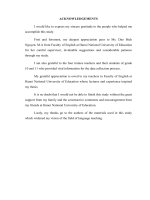An investigation into English major freshmen's perceptions on, attitudes towards and perferences for teacher's written corrective feedback at Hanoi University o
Bạn đang xem bản rút gọn của tài liệu. Xem và tải ngay bản đầy đủ của tài liệu tại đây (184.56 KB, 4 trang )
VIETNAM NATIONAL UNIVERSITY, HANOI
UNIVERSITY OF LANGUAGES AND INTERNATIONAL STUDY
FACULTY OF POST-GRADUATE STUDIES
NGUYỄN THỊ ĐAN QUẾ
AN INVESTIGATION INTO ENGLISH MAJOR FRESHMEN’S
PERCEPTIONS ON, ATTITUDES TOWARDS AND
PERFERENCES FOR TEACHER’S WRITTEN CORRECTIVE
FEEDBACK AT HANOI UNIVERSITY OF INDUSTRY
NHẬN THỨC, THÁI ĐỘ VÀ MONG MUỐN CỦA SINH VIÊN NĂM THỨ NHẤT
CHUYÊN NGÀNH TIẾNG ANH ĐỐI VỚI PHẢN HỒI CHỮA LỖI CỦA GIÁO VIÊN
TRÊN BÀI VIẾT CỦA SINH VIÊN TẠI TRƯỜNG ĐẠI HỌC CÔNG NGHIỆP HÀ NỘI
M.A. Minor Programme Thesis
Field: English Teaching Methodology
Code: 601410
HANOI – 2010
VIETNAM NATIONAL UNIVERSITY, HANOI
UNIVERSITY OF LANGUAGES AND INTERNATIONAL STUDY
FACULTY OF POST-GRADUATE STUDIES
NGUYỄN THỊ ĐAN QUẾ
AN INVESTIGATION INTO ENGLISH MAJOR FRESHMEN’S
PERCEPTIONS ON, ATTITUDES TOWARDS AND
PERFERENCES FOR TEACHER’S WRITTEN CORRECTIVE
FEEDBACK AT HANOI UNIVERSITY OF INDUSTRY
NHẬN THỨC, THÁI ĐỘ VÀ MONG MUỐN CỦA SINH VIÊN NĂM THỨ NHẤT
CHUYÊN NGÀNH TIẾNG ANH ĐỐI VỚI PHẢN HỒI CHỮA LỖI CỦA GIÁO VIÊN
TRÊN BÀI VIẾT CỦA SINH VIÊN TẠI TRƯỜNG ĐẠI HỌC CÔNG NGHIỆP HÀ NỘI
M.A. Minor Programme Thesis
Field: English Teaching Methodology
Code: 601410
Supervisor: Thái Hà Lam Thủy, M.Ed.
HANOI - 2010
iv
TABLE OF CONTENTS
Declaration i
Acknowledgements ii
Abstract iii
Table of contents iv
Abbreviations vi
Lists of charts and tables vi
PART I: INTRODUCTION 1
1. Background of the study 1
2. Aims of the study and research questions 2
3. Methods of the study 3
4. Scope of the study 3
5. Significance of the study 3
6. Structure of the study 4
PART II: DEVELOPMENT 5
CHAPTER 1: LITERATURE REVIEW 5
1.1. Theoretical backgrounds of teaching writing 5
1.1.1. Definition of writing 5
1.1.2. The importance of teaching writing 5
1.1.3. An overview of approaches to teaching writing 6
1.1.3.1. The product-oriented approach to teaching writing 7
1.1.3.2. The process-oriented approach to teaching writing 7
1.1.4. The writing process 8
1.2. Theoretical backgrounds of teacher written corrective feedback 9
1.2.1. Definition of teacher’s written corrective feedback 9
1.2.2. Controversy over the effectiveness of teacher written corrective feedback 11
1.2.3. The importance of teacher’s written corrective feedback 12
1.2.4. Feedback approaches 13
1.2.4.1. Single-draft approach vs. Multiple-draft approach 13
1.2.4.2. Comprehensive strategy vs. Selective strategy 14
1.2.5. Types of teacher written corrective feedback 15
1.2.5.1. Form focus vs. content focus feedback 15
v
1.2.5.2. Direct vs. indirect feedback 15
1.2.5.3. Positive feedback vs. negative feedback 16
1.2.5.4. Text-specific vs. generic feedback 17
1.2.5.5. Margin feedback vs. linear feedback and end feedback 17
1.2.6. Forms of teacher written commentary 18
CHAPTER 2: METHODOLOGY 19
2.1. The setting of study 19
2.2. Methodology 21
2.2.1. Participants 21
2.2.2. Research Design 21
2.2.2.1. Research Questions: 21
2.2.2.2. Data collection methods 21
2.2.2.3. Data collection procedure 23
2.2.2.4. Data analysis methods 23
CHAPTER 3: DATA ANALYSIS AND FINDINGS 24
3.1. Data analysis of questionnaires 24
3.1.1. Students’ general information 24
3.1.2. Students’ perceptions and attitudes to teacher’s written corrective feedback 25
3.1.3. Students’ preferences for teacher feedback 30
3.2. Results of the interview and class observation 33
3.3. Findings and discussions 37
3.4. Implications of the study 40
PART III: CONCLUSION 42
References 43
Appendices I









